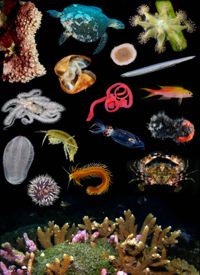Smithsonian chooses VIMS prof to lead Tennenbaum Marine Observatories
Professor Emmett Duffy of the Virginia Institute of Marine Science, College of William & Mary, has been appointed director of the Smithsonian’s Tennenbaum Marine Observatories, effective September 16. He will be the first to lead this new initiative, a major long-term project to study coastal marine biodiversity and ecosystems around the globe.

Duffy, Loretta and Lewis Glucksman Professor of Marine Science and head of the Marine Biodiversity Lab at VIMS, will initially split his time between the VIMS campus in Gloucester Point, Virginia—where he will continue to supervise ongoing research projects—and the Smithsonian’s National Museum of Natural History in Washington, D.C. Duffy has been at VIMS since 1994.
The Smithsonian announced the Tennenbaum Marine Observatories in October 2012 with a $10 million donation from philanthropists Suzanne and Michael Tennenbaum. Mr. Tennenbaum is senior managing partner of Los Angeles-based Tennenbaum Capital Partners.
The project will be the first worldwide network of coastal ecological field sites to standardize measurements of biological change and experiments to understand their causes. Experts in biology, ecology, and anthropology will study the sites using both traditional field studies and cutting-edge technologies like DNA sequencing. The network will provide a unique understanding of how marine biodiversity is affected by local human activities and global change, such as ocean warming, acidification, and rising sea levels.
“The Tennenbaum Marine Observatories Network is launching an unprecedented effort to address profoundly important questions—how we are changing the global ocean’s life and how those changes will come back to affect all of us,” said Duffy. “I am thrilled to join the Smithsonian to help lead this bold new program.”
VIMS Dean and Director John Wells says, “The Smithsonian couldn’t have chosen a better scientist to lead this global endeavor. We at VIMS will sorely miss Emmett’s contributions as a friend and colleague, but we know that this position provides a great opportunity for him to continue his pioneering efforts to understand, monitor, and sustain marine biodiversity in coastal zones around the world.”
Duffy’s long-term research has focused on how environmental change affects the complex interactions among marine animals and plants, and how these translate into the natural services on which humans depend. Most recently, he led the ZEN Network, a 3-year project funded by the U.S. National Science Foundation to study how nutrient pollution and changes in biodiversity impact seagrass beds at 15 sites around the world, including in Japan, along the East and West coasts of the U.S., and up the Atlantic coast of Europe from Portugal to Norway. ZEN has recently been awarded funding for a second generation that will expand to roughly 40 sites worldwide.
In his new position, Duffy will oversee development of an overarching marine observatory network, which will build from five initial field sites: the Smithsonian Environmental Research Center in Edgewater, Maryland, on Chesapeake Bay; the Smithsonian’s marine stations at Fort Pierce, Florida and Carrie Bow Cay in Belize; and the Smithsonian Tropical Research Institute’s two locations in Panama—Bocas Del Toro on the Caribbean and Naos station on the Pacific.
As the project grows, the Smithsonian will establish additional research sites with collaborators around the globe to monitor coastal ocean health, with the goal of at least 10 new sites within the next decade.
 Project scientists will
identify specific areas at each site where they will record the diversity and
abundance of marine organisms on a regular basis. They will complement these
data with other standardized measures of physics and chemistry at each site, and
with complementary experiments conducted across all sites.
Project scientists will
identify specific areas at each site where they will record the diversity and
abundance of marine organisms on a regular basis. They will complement these
data with other standardized measures of physics and chemistry at each site, and
with complementary experiments conducted across all sites.
Studying each site using the same methods over a long period of time will generate a globally coordinated knowledge base that will allow the scientists—for the first time—to comprehensively study environmental change around the world’s coasts. These long-term data are critical for addressing current and future challenges to sustaining a healthy ocean.
Duffy is the author of more than 100 articles on marine biodiversity and ecology and was the 2011 recipient of Japan’s inaugural Kobe Award in Marine Biology for his groundbreaking discovery of advanced social colonies in tropical shrimp. His research has been featured in the BBC’s The Blue Planet series, textbooks, and media outlets worldwide. He was awarded an Aldo Leopold Leadership Fellowship in 2006, a Virginia Outstanding Faculty Award in 2013, and has since co-led major synthetic efforts to put biodiversity science to work in informing public policy, education, and awareness. These include a 2012 international consensus document in the journal Nature linking biodiversity to ecosystem health, the first-ever inclusion of ocean ecosystems in the quadrennial U.S. National Climate Assessment, and an interagency group envisioning a national marine biodiversity observation network.
Duffy holds a Ph.D. from the University of North Carolina at Chapel Hill. Prior to arriving at VIMS, he held research fellowships at the Smithsonian Institution and the University of California, Davis.
The Tennenbaum Marine Observatories Network is modeled on a similar forest-based project—the Smithsonian Institution Global Earth Observatories (known as SIGEO)—that includes 51 land plots around the globe where scientists have been monitoring and comparing the dynamics of forested habitats for 35 years. Due to its success, the Smithsonian is using it as the model to look at the marine realm.
Eva Pell, Under Secretary for Science at the Smithsonian, says “We are committed to long-term earth observations that inform science and the public at large regarding ecosystem changes over extended time frames. The Tennenbaum Marine Observatories Network will allow the Smithsonian and its partners to follow changes in the marine environment broadly at different latitudes and longitudes around the world."

